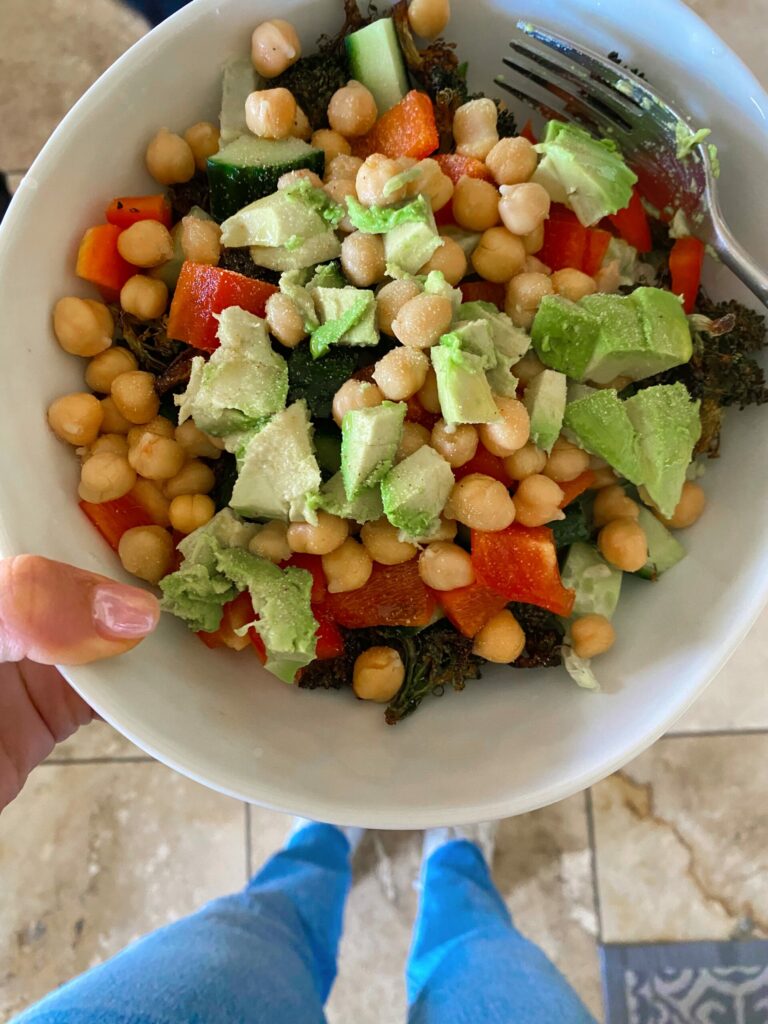Can you develop muscles in a calorie deficit? Learn to lose fat, improve body composition and preserve muscles while losing weight.
Hi friends! How was the weekend? I hope you had an excellent one! It was an action from Liv’s school, which was very fun, and we also had the usual things like basketball matches, mass and dinner with the family. I roasted in my sauna blanket and looked at The voice. The pilot came home after a long trip, so we were happy to find our favorite guy!
Today’s blog subject is strong and a question that often asks me:
Can you develop muscles in a calorie deficit
If you have already tried to lose weight, you know that there are so many promising methods: intermittent fasting, low -carbohydrate plans, points systems, meal replacement shakes, juice cleaning and classic calories deficit.
When I learned for the first time the concept of a calorie deficit as a trainer, I saw how effective it can be for fat loss. But I also noticed that many women who cut the calories ended up losing not only fat, but also precious muscle mass.
This is important because muscle is a metabolically active fabric. It improves the composition of your body, supports the health of hormones, increases energy expenditure at rest and facilitates daily activities. Build more muscle helps you burn more calories at rest and keep your results.
A question that I often hear is:
“Can you really develop muscles while losing fats in a calorie deficit?”
Today, I wanted to answer this popular question, discuss what a calorie deficit is, the way it works for fat loss and what it really takes to develop or maintain muscles while losing fat.
What is the calorie deficit
A calorie deficit occurs when you consume fewer calories than your body needs to maintain its current weight.
Your body has a level of maintenance caloric: the amount of energy required every day to keep you alive and active without gaining or losing weight. When you eat constantly below this level, your body is based on energy stored such as body fat to make the difference.
For example: if your body burns 2,000 calories per day but you consume 1,500 calories, you create a deficit of 500 calories. Over time, this energy difference can cause weight loss, ideally by mobilizing fat stores.
How a calorie deficit works
Creates an energy difference
A calorie deficit obliges the body to rely on stored energy – mainly body fat but sometimes lean tissues – to meet daily needs.
Affects body composition
Although a deficit promotes fat loss, it can also cause muscle loss if the protein is inadequate or if you do not perform resistance exercises. The preservation of muscles is essential to reach a lean and strong aspect rather than simply becoming smaller.
Impact of performance and recovery
Serious deficits can reduce energy levels, hinder resistance training and slow recovery. This can make it more difficult to maintain or build muscles in a calorie deficit.
Can you gain muscle in a calorie deficit
Winning a significant new muscle generally requires a slight surplus of calories as well as gradual overload and recovery.
However, some people can develop muscles while losing fat in specific circumstances:
Beginners or those who return to training: The body reacts quickly to resistance training, even without excess.
Individuals with higher body fat: Stored energy can help power a certain muscle gain while losing fat.
For experienced weightlifting, the main objective of a deficit should be interview Muscle existing while losing fats, without expecting large quantities of new muscle growth.
How to develop muscles in a calorie deficit
To maximize your results, focus on the following fundamental principles:
Priorify protein intake
Adequate proteins support muscle repair and retention. Most research suggests targeting 0.7 to 1 gram of protein per body of body weight every day, distributed evenly over meals. Please keep in mind that protein objectives vary depending on the objectives; For longevity, you actually need less protein than you think, but for body composition, you may need a little more.
For a recipe inspiration, see my Protein -rich meal preparation ideas To help you reach your protein intake targets regularly.
Focus on resistance training
Resistance training is essential to report to your body to preserve and potentially develop muscles while losing fat. Incorporate lifting weights, body weight exercises or resistance bands 3 to 4 times a week. Emphasize compound movements – such as squats, lifting earth, rows and presses – to engage large muscle groups.
Use progressive overload
Continue to challenge your muscles by gradually increasing the weight, rehearsals, sets or slowdown in the tempo. This continuous stimulus indicates to your body that muscle tissue is necessary and should be kept even during fat loss. I have a podcast on gradual overload here.
Avoid aggressive calories cuts
A moderate caloric deficit of approximately 250 to 500 calories per day is generally sufficient to support a constant fat loss while maintaining the energy for resistance exercises and recovery. Stronger deficits may increase the risk of muscle degradation. In addition, this is one of the many reasons why it may be advantageous to work with a professional for body composition or fatty loss objectives.
When many of my clients come for the first time, they don’t eat enough and their hormones are not happy; If we had a cut, it would do nothing. (In addition, I will not suggest a cut for someone who eats only 1,200 calories per day.) We have to focus on the lifestyle foundations, rebuild their metabolism by an inverted diet, then when we finally cut, the results are incredible. If you have already been a deficit and a plate, a greater reduction will not work. The body must feel safe and nourished before it can start losing weight / fat.
Prioritize recovery and sleep
Muscle repair and growth occur during rest. Aim 7 to 9 hours of quality sleep every night and take at least one or two days of rest per week. Good recovery also supports the balance of hormones, which is important when building muscles while losing fat.
Concentrate on the quality of nutrients
Provide your body with whole foods: lean proteins, complex carbohydrates, healthy fats, fruits and vegetables. Prioritize the consumption of enough protein with each meal to help preserve muscle mass and use carbohydrates strategically around training to maintain performance.
What is the best calorie deficit to lose fat and win muscles
The best calorie deficit is that which is moderate and durable. For most women aimed at losing weight and improving body composition, a daily deficit of 250 to 500 calories – combined with high protein intake and constant resistance formation – can be effective, depending on what they do.
This approach generally supports a fat loss rate of approximately 0.5 to 1 book per week while minimizing muscle loss and maintaining the intensity of training.
If you wondered “Can you develop muscles in a calorie deficit?” The answer is that it is possible under certain conditions. Beginners, those who have higher body fat or people who return to constant resistance training can see muscle winning while leaning.
For others, the realistic objective should be to preserve the muscles while losing fat. Using moderate calorie deficit, prioritizing the gram of protein targets, training with progressive resistance exercises and obtaining adequate recovery, you can improve your body composition – less fat, more muscle and better overall performance.
If you are looking for a guide to help you with your body composition goals, I have something on the way to you. Comment below and type me and I can add to the interest list!
xo
Gina


















